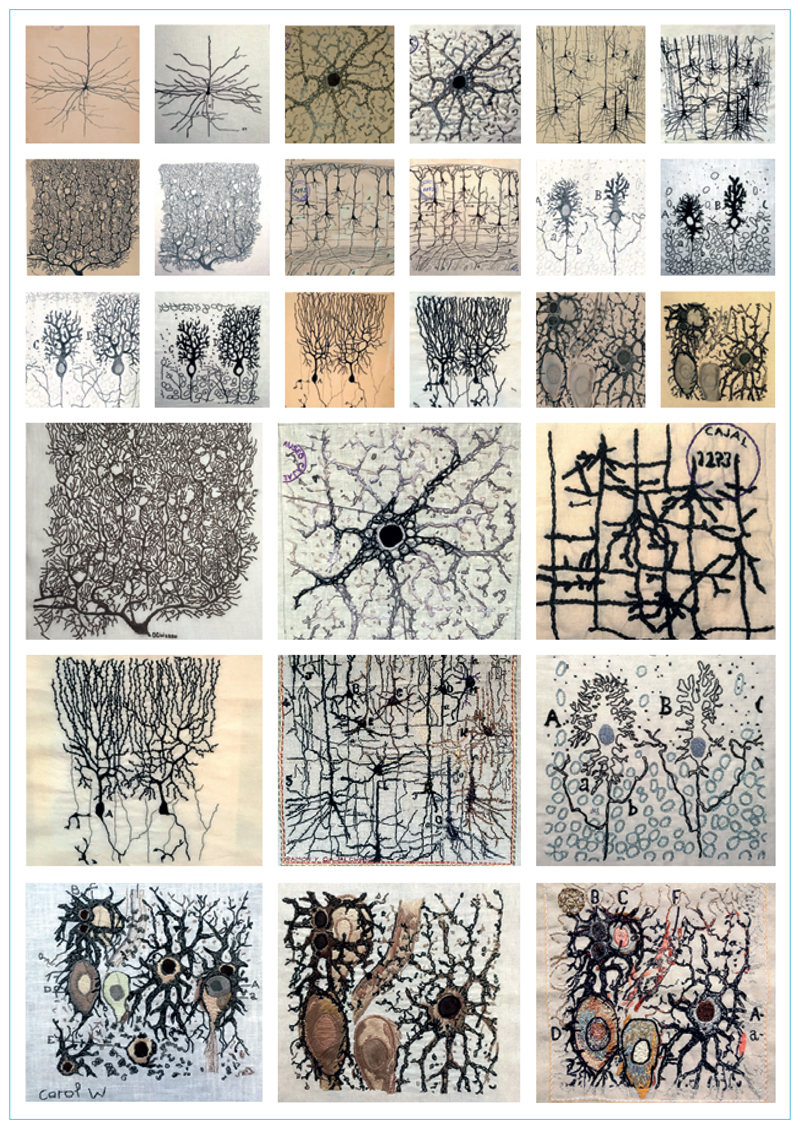“It is no exaggeration […] to say that he [Cajal] with his pupils, especially Achucarro, Hortego [sic], and de Castro, opened a fresh era of knowledge. […] Never has anyone started out on a great research more single-handed than at his beginning did he. But as the years went by, if ever man had a school it was Cajal; a school of colleagues and pupils.”
Charles S Sherrington (1935)
The Cajal Embroidery Project celebrates the centenary of the 1920 Royal Decree that established the illustrious Instituto Cajal in Madrid, Spain. Over 75 volunteers collaborated across six countries to create 81 intricate, exquisite hand-stitched panels of Ramón y Cajal’s images, which were then curated and displayed by Edinburgh Neuroscience at the virtual FENS 2020 Forum. The Project pays homage to the fascinating history of the institution and its founder, Santiago Ramón y Cajal (1852–1934). He is well known for his pioneering, consummate, and informative illustrations of neurons and their arborisations that ultimately demonstrated the notion that brain cells are distinct, diverse units, which communicate with one another. That acknowledgment—of individuality and interconnectedness—is borne out in our Project (figure). Some volunteers chose to emulate even the circular blue-ink stamp with the words ‘Museo Cajal, Madrid’ and a number handwritten by Pedro Manzano, the caretaker who first catalogued Ramón y Cajal’s drawings.
Figure. The Cajal Embroidery Project.
The top three rows show pairs of an original Ramón y Cajal illustration (left) and an embroidery artwork panel (right). The bottom three rows show embroidery artwork panels in more detail. Overall, the 81 panels (each 9 × 9 inches, or 23 × 23 cm), when stitched together, create a masterpiece exceeding 4 square metres.
Ramón y Cajal performed many of his neuropathological studies in solitude, in a laboratory fashioned in the attic of his own house. Contributors to our Project (appendix), many of whom were introduced to neuroscience or embroidery de novo, toiled in similar circumstances, owing to the lockdown measures mandated by the COVID-19 pandemic. In an attempt to give coherence to the Project and resemblance to the original depictions, we stipulated that the fabric used should be ivory or cream cotton or linen, and that the thread should be black or dark brown. However, when haberdashers shut up shop, our volunteers had to be creative and adventurous, improvising with new techniques; thus, some cut up old sheets, dyeing them with teabags to achieve the sepia-coloured background, to good effect. Ramón y Cajal himself refined fellow Nobel Laureate Camillo Golgi’s la reazione nera staining technique by applying silver nitrate to specimens via two brief pulses, rather than soaking them for two days.
The Cajal Institute, which continues to flourish, put Spain at the forefront of neuroscience research, with several scientific giants graduating from it, such as Pío del Río Hortega (1882–1945), who discovered oligodendrocytes and microglia. Even now, many neuroscientists both in Spain and elsewhere have a sense of belonging to the tradition and values laid down by Ramón y Cajal. The output of the Cajal Embroidery Project (video) serves as a memento of such accomplishment and the power of our neuroscience community to embrace our rich history.
Supplementary Material
Associated Data
This section collects any data citations, data availability statements, or supplementary materials included in this article.



